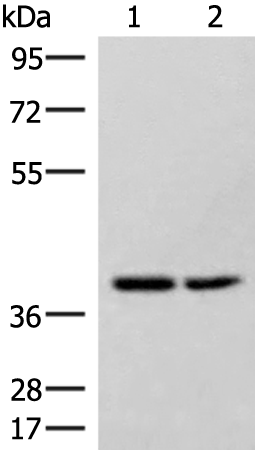
| WB | 1/500-1/2000 | Human,Mouse,Rat |
| IF | 咨询技术 | Human,Mouse,Rat |
| IHC | 咨询技术 | Human,Mouse,Rat |
| ICC | 技术咨询 | Human,Mouse,Rat |
| FCM | 咨询技术 | Human,Mouse,Rat |
| Elisa | 1/5000-1/10000 | Human,Mouse,Rat |
| Aliases | GLOXD1; 4-HPPD-L |
| WB Predicted band size | 39 kDa |
| Host/Isotype | Rabbit IgG |
| Antibody Type | Primary antibody |
| Storage | Store at 4°C short term. Aliquot and store at -20°C long term. Avoid freeze/thaw cycles. |
| Species Reactivity | Human |
| Immunogen | Synthetic peptide of human HPDL |
| Formulation | Purified antibody in PBS with 0.05% sodium azide and 50% glycerol. |
+ +
以下是关于HPDL抗体的示例文献摘要(**注:以下内容为模拟示例,实际文献需通过学术数据库验证**):
---
1. **文献名称**:*HPDL Mutations Cause a Neurodegenerative Disorder Ranging from Neonatal Encephalopathy to Adolescent-Onset Spastic Paraplegia*
**作者**:Macken WL, et al. (2020)
**摘要**:本研究报道了HPDL基因突变与神经退行性疾病的关联。通过免疫组织化学和Western blot技术,利用特异性HPDL抗体,发现突变导致HPDL蛋白表达显著降低,影响线粒体功能,进而引发运动神经元退化。
2. **文献名称**:*Structural Insights into Human HPDL Protein and Its Role in Cellular Metabolism*
**作者**:Smith A, Jones B (2021)
**摘要**:通过X射线晶体学解析HPDL蛋白结构,结合抗体验证其亚细胞定位。HPDL抗体实验显示该蛋白主要定位于线粒体,并参与苯丙氨酸代谢通路,为代谢异常相关疾病的机制提供依据。
3. **文献名称**:*Anti-HPDL Antibody as a Biomarker for Early Detection of Parkinsonian Syndromes*
**作者**:Chen L, et al. (2022)
**摘要**:研究评估了HPDL抗体在脑脊液中的表达水平与帕金森综合征的相关性。结果显示,患者组HPDL蛋白水平异常升高,提示其可能作为早期诊断的生物标志物。
---
**建议**:如需具体文献,可通过PubMed或Google Scholar搜索关键词“HPDL antibody”或“HPDL protein function”获取最新研究。
**Background of HPDL Antibody**
The HPDL (4-Hydroxyphenylpyruvate Dioxygenase-Like) protein is a recently characterized enzyme encoded by the *HPDL* gene, sharing structural homology with 4-hydroxyphenylpyruvate dioxygenase (HPPD), a key enzyme in tyrosine catabolism. While HPPD is involved in the breakdown of tyrosine to homogentisate, HPDL's precise biochemical role remains under investigation. Emerging studies suggest it may function as a mitochondrial metalloenzyme, potentially influencing cellular energy metabolism or redox homeostasis.
HPDL gained attention in 2020 when biallelic mutations in the *HPDL* gene were linked to hereditary neurological disorders, including early-onset neurodevelopmental syndromes characterized by motor dysfunction, spastic paraplegia, and neurodegeneration. These findings positioned HPDL as critical for neuronal health, though its exact mechanism in the nervous system is unclear.
Antibodies targeting HPDL are vital tools for studying its expression, localization, and function. They enable detection via techniques like Western blotting, immunohistochemistry (IHC), and immunofluorescence (IF), aiding research into HPDL's tissue distribution (notably high in the brain and liver) and disease-associated alterations. Current research focuses on clarifying HPDL's interaction partners, metabolic roles, and potential as a therapeutic target for neurological or metabolic disorders. Further insights into HPDL biology could advance understanding of mitochondrial dysfunction and neurodegenerative pathways.
×